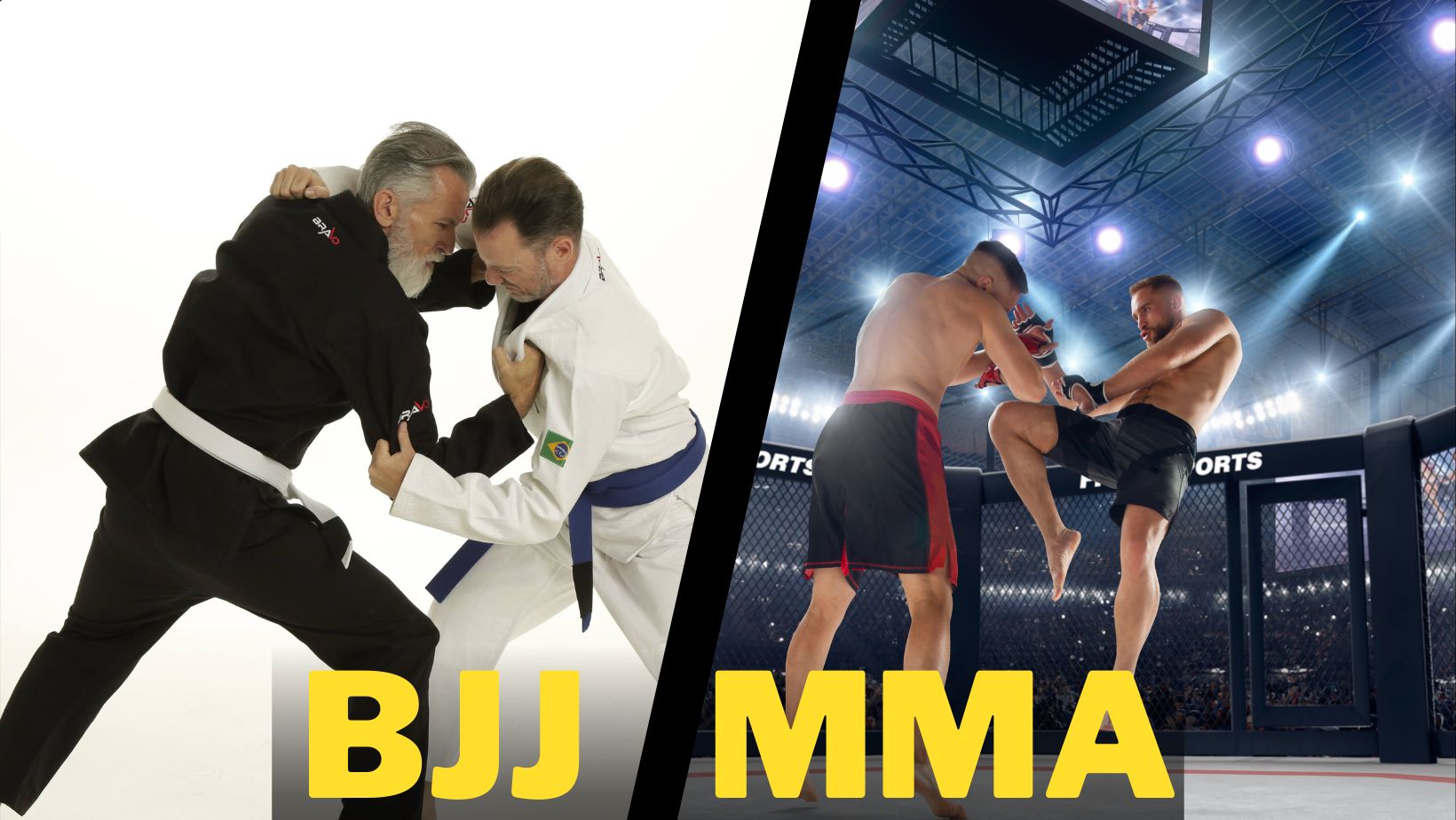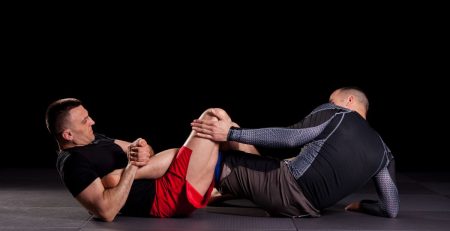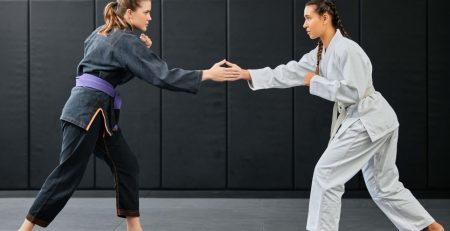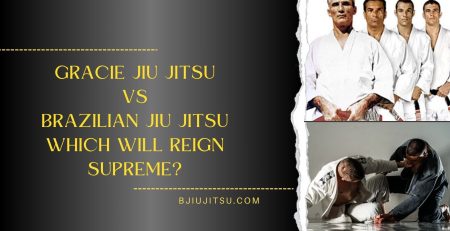Brazilian Jiu Jitsu vs MMA – Where Skill Meets Savagery?
Table of Contents
- Introduction to Brazilian Jiu Jitsu (BJJ) and Mixed Martial Arts (MMA)
- Historical Origins
- The History of Brazilian Jiu Jitsu
- The History of Mixed Martial Arts
- Fundamental Techniques and Training
- BJJ Techniques and Training
- MMA Techniques and Training
- Competitive Differences
- BJJ Competition Rules and Scoring
- MMA Competition Rules and Scoring
- Physical and Mental Demands
- Physical Conditioning in BJJ
- Physical Conditioning in MMA
- Mental Toughness in Both Sports
- Self-Defense Applications
- BJJ for Self-Defense
- MMA for Self-Defense
- Cultural and Community Aspects
- The Culture of BJJ
- The Culture of MMA
- The Path to Mastery
- Progression in BJJ
- Progression in MMA
- Cross-Training: Benefits and Challenges
- Advantages of Training in Both BJJ and MMA
- Potential Challenges and Considerations
- Conclusion: Choosing Your Path
Introduction to Brazilian Jiu Jitsu (BJJ) and Mixed Martial Arts (MMA)
Brazilian Jiu Jitsu (BJJ) and Mixed Martial Arts (MMA) are two of the most popular and respected disciplines in the world of martial arts. Both have unique attributes and attract different kinds of practitioners, yet they share many similarities and complement each other in various ways. BJJ, often referred to as the “gentle art,” focuses on ground fighting, submissions, and leveraging technique over brute strength. It teaches practitioners how to control and neutralize opponents through a series of carefully orchestrated movements and holds. On the other hand, MMA is a hybrid combat sport that combines techniques from various martial arts, including boxing, kickboxing, Muay Thai, wrestling, and BJJ itself. This blend creates a dynamic and versatile fighting style that requires proficiency in both striking and grappling.
Understanding the fundamental differences and similarities between BJJ and MMA is crucial for anyone interested in pursuing martial arts. Whether your goal is self-defense, competition, or simply personal development, both disciplines offer unique benefits and challenges. This blog post aims to provide a comprehensive comparison of BJJ and MMA, exploring their histories, techniques, competitive structures, and more to help you make an informed decision about which path to follow.
Historical Origins
The History of Brazilian Jiu Jitsu
Brazilian Jiu Jitsu traces its roots back to the early 20th century when Japanese judo master Mitsuyo Maeda brought his knowledge of judo to Brazil. Maeda’s teachings found a receptive audience in the Gracie family, particularly brothers Carlos and Hélio Gracie. Hélio, in particular, faced challenges due to his smaller stature, which led him to modify traditional judo techniques to rely more on leverage and technique rather than strength. These modifications gave birth to Brazilian Jiu Jitsu, a martial art focused on ground fighting and submissions.
The Gracie family played a crucial role in popularizing BJJ, both in Brazil and internationally. Their challenge matches, often referred to as “Vale Tudo” (anything goes) fights, showcased the effectiveness of BJJ against other martial arts. The establishment of the Ultimate Fighting Championship (UFC) in the 1990s further catapulted BJJ into the limelight, with Royce Gracie demonstrating its effectiveness in real combat situations against much larger and often more physically imposing opponents. For more detailed insights on “Brazilian Jiu Jitsu,” you can check out this comprehensive article Brazilian Jiu Jitsu.
The History of Mixed Martial Arts
Mixed Martial Arts, as we know it today, also has deep historical roots, though it is more of a modern synthesis of various martial arts styles. Ancient forms of mixed combat sports can be traced back to ancient Greece with pankration, a no-holds-barred competition that combined striking and grappling. Similar hybrid forms of combat existed in other cultures, such as the Chinese Leitai and Japanese Shooto.
The modern era of MMA began to take shape in the 20th century, particularly with the rise of Vale Tudo in Brazil, where fighters from different disciplines would compete with minimal rules. The formation of the UFC in 1993 marked a significant turning point. Initially conceived to determine the most effective martial art in a no-rules environment, it quickly evolved into a sport of its own, with fighters cross-training in various disciplines to become well-rounded competitors.
Today, MMA is a globally recognized sport with established organizations like the UFC, Bellator, and ONE Championship hosting events that draw millions of viewers. The sport’s evolution has led to the development of a comprehensive training methodology that integrates the best techniques from multiple martial arts, making it one of the most versatile and demanding combat sports.
Fundamental Techniques and Training
BJJ Techniques and Training
Brazilian Jiu Jitsu is renowned for its intricate techniques and strategic approach to combat. Training typically begins with learning the fundamental positions: guard, mount, side control, and back control. Each position offers specific advantages and vulnerabilities, and mastering transitions between these positions is crucial.
Key techniques in BJJ include joint locks, such as armbars and kimuras, and chokes, such as the rear-naked choke and triangle choke. These techniques are designed to force an opponent to submit, effectively neutralizing the threat without inflicting severe injury. BJJ practitioners spend countless hours drilling these techniques, often starting with cooperative drills before progressing to live sparring, known as “rolling.”
One of the unique aspects of BJJ is its belt system, which provides a clear progression path from white belt to black belt. Each belt represents a significant milestone in a practitioner’s journey, requiring not only technical proficiency but also a deep understanding of the art’s philosophy and strategy. Training in BJJ also emphasizes physical conditioning, flexibility, and mental toughness, as practitioners often face physically and mentally demanding situations on the mat. If you are looking to start or enhance your training, you can find useful tips and guidance in Brazilian Jiu Jitsu Training.
MMA Techniques and Training
Mixed Martial Arts training is inherently multidisciplinary, requiring practitioners to develop skills in striking, grappling, and clinch work. Training camps typically include separate sessions for boxing, kickboxing, Muay Thai, wrestling, and Brazilian Jiu Jitsu, among others. The goal is to create a well-rounded fighter capable of handling any situation inside the cage.
Striking techniques in MMA are drawn from disciplines like boxing and Muay Thai, emphasizing punches, kicks, elbows, and knees. Grappling techniques borrow heavily from wrestling and BJJ, focusing on takedowns, ground control, and submissions. Clinch work, which is often neglected in other martial arts, is crucial in MMA for controlling opponents and setting up strikes or takedowns.
MMA training is notoriously intense, often involving rigorous conditioning programs designed to improve strength, endurance, and explosiveness. Fighters must also spar regularly to develop their timing, distance management, and ability to adapt to different opponents. The diverse nature of MMA training demands a high level of discipline and commitment, as fighters must constantly refine their skills across multiple disciplines.
Competitive Differences
BJJ Competition Rules and Scoring
Brazilian Jiu Jitsu competitions are primarily focused on grappling, with a strong emphasis on technique and control. Matches typically begin with both competitors standing, and the goal is to either submit the opponent or accumulate points through various positional advancements and techniques. The International Brazilian Jiu Jitsu Federation (IBJJF) is one of the most widely recognized governing bodies, and its rule set is commonly used in competitions.
Points are awarded for actions that demonstrate control and advancement, such as passing the guard, achieving mount, and taking the opponent’s back. Specific point values are assigned to these actions: for example, passing the guard earns 3 points, while securing mount or back control earns 4 points. Advantages, which are near-point actions that come close to achieving a scoring move, can also be awarded and can determine the winner in closely contested matches.
BJJ competitions can be held in both Gi (traditional kimono) and No-Gi formats, each presenting its own unique challenges. Gi competitions allow for a wide range of grips and techniques that leverage the opponent’s clothing, while No-Gi competitions emphasize speed and athleticism, with fewer grips and more reliance on body positioning and leverage.
MMA Competition Rules and Scoring
Mixed Martial Arts competitions are governed by a more complex set of rules designed to ensure the safety of the fighters while allowing for a broad range of techniques. The Unified Rules of MMA, used by most major organizations, outline specific regulations for strikes, submissions, and illegal actions.
MMA fights are typically conducted in a cage or ring, with matches divided into rounds, usually three five-minute rounds for regular bouts and five five-minute rounds for championship fights. Fighters can win by knockout, submission, or judges’ decision if the fight goes the distance. The 10-point must system is commonly used for scoring, with the winner of each round receiving 10 points and the loser receiving 9 or fewer, depending on the level of dominance demonstrated.
Effective striking, grappling, aggression, and cage control are the primary criteria used by judges to score fights. This scoring system encourages fighters to be well-rounded and maintain a balance between offensive and defensive tactics. Illegal moves, such as eye gouging, groin strikes, and strikes to the back of the head, result in warnings, point deductions, or disqualification. If you are interested in learning about the top fighters who have excelled in both Brazilian Jiu Jitsu and MMA, take a look at Best Brazilian jiu jitsu fighter in MMA.
For further information about “Brazilian Jiu-Jitsu vs. wrestling,” you can check out this article: Brazilian Jiu Jitsu vs Wrestling.
For further information about “Brazilian Jiu-Jitsu vs. bodybuilder,” you can check out this article: Brazilian Jiu Jitsu vs Bodybuilder.
For further information about “Brazilian Jiu-Jitsu vs. kickboxing,” you can check out this article: Brazilian Jiu Jitsu vs Kickboxing.
Physical and Mental Demands
Physical Conditioning in BJJ
Brazilian Jiu Jitsu places significant demands on the body, requiring a blend of strength, flexibility, and endurance. Practitioners must develop core strength to maintain balance and control during grappling exchanges. Flexibility is crucial for executing and defending against submissions, particularly those involving the legs and hips.
Endurance is another critical component, as BJJ matches can be long and physically taxing. Cardiovascular conditioning helps practitioners maintain a high level of performance throughout extended rolling sessions or competitive matches. Strength training, particularly functional strength exercises, supports the physical demands of grappling and enhances overall performance.
In addition to physical conditioning, injury prevention and recovery are important aspects of BJJ training. Common injuries include joint strains, muscle tears, and bruises, so practitioners must incorporate proper warm-ups, stretching routines, and recovery strategies to stay healthy and continue training effectively.
Physical Conditioning in MMA
Mixed Martial Arts requires an even broader range of physical attributes due to its multidisciplinary nature. Fighters must develop explosive power for striking, takedowns, and defensive movements. Strength training, including weightlifting and bodyweight exercises, is crucial for building the necessary power and resilience.
Cardiovascular conditioning is paramount in MMA, as fighters must maintain high levels of energy and agility throughout multiple rounds of combat. This often involves a mix of aerobic and anaerobic training, such as running, high-intensity interval training (HIIT), and sport-specific drills.
Flexibility and mobility are also important to allow fighters to move efficiently and avoid injuries. Stretching, yoga, and mobility exercises are commonly incorporated into training routines. Recovery and injury prevention play a significant role in MMA due to the high-impact nature of the sport. Techniques such as foam rolling, massage, and proper rest are essential for maintaining peak physical condition.
Mental Toughness in Both Sports
Both Brazilian Jiu Jitsu and Mixed Martial Arts demand a high level of mental toughness. BJJ practitioners must develop patience, strategic thinking, and the ability to stay calm under pressure. The mental challenge of continuously solving problems and adapting to opponents’ movements fosters resilience and mental agility.
MMA fighters face similar mental challenges but must also cope with the added pressure of striking exchanges and the potential for significant physical harm. Mental preparation, including visualization, mindfulness, and psychological conditioning, helps fighters manage stress and maintain focus during high-stakes situations.
In both sports, the mental toughness developed through consistent training and competition translates to other areas of life, promoting confidence, discipline, and perseverance.
Self-Defense Applications
BJJ for Self-Defense
Brazilian Jiu Jitsu is highly regarded for its effectiveness in self-defense situations. Its focus on grappling and submissions allows practitioners to control and neutralize opponents without relying on strikes, which can be beneficial in situations where minimizing harm is a priority. BJJ techniques enable individuals to defend themselves against larger and stronger attackers by using leverage and technique.
In self-defense scenarios, BJJ emphasizes the importance of position and control. Techniques such as guard sweeps, escapes, and submissions can incapacitate an aggressor, providing a safe exit or allowing for the control of the situation until help arrives. Additionally, BJJ training fosters situational awareness and the ability to remain calm under pressure, both of which are crucial in real-world confrontations. For those who want to understand how Brazilian Jiu Jitsu can be applied in self-defense scenarios, this article Brazilian Jiu Jitsu Self Defense offers valuable information. Lastly,
MMA for Self-Defense
Mixed Martial Arts offers a comprehensive approach to self-defense by incorporating striking, grappling, and clinch work. The versatility of MMA training prepares practitioners to handle a wide range of self-defense scenarios, from stand-up confrontations to ground altercations. The striking techniques from boxing and Muay Thai provide effective tools for defending against attacks, while the grappling and submission skills from BJJ and wrestling ensure control in close-quarters situations.
MMA’s holistic approach means practitioners are well-equipped to adapt to different threats and respond effectively. However, the full-contact nature of MMA also means that practitioners must be mindful of the potential legal and ethical implications of using such techniques in self-defense situations. Proper training emphasizes the importance of de-escalation and using force appropriately to ensure safety and compliance with legal standards.

Cultural and Community Aspects
The Culture of BJJ
The culture of Brazilian Jiu Jitsu is deeply rooted in respect, discipline, and camaraderie. BJJ academies often foster a strong sense of community, with practitioners forming close bonds through shared training experiences. The emphasis on mutual respect is evident in the traditional bowing and adherence to etiquette on the mats.
BJJ culture also celebrates continuous learning and personal growth. Practitioners are encouraged to embrace the journey, understanding that mastery takes time and dedication. This culture of perseverance and humility contributes to a supportive environment where individuals of all ages, backgrounds, and skill levels can thrive.
The Culture of MMA
Mixed Martial Arts culture is similarly built on respect and discipline but also emphasizes the competitive and aggressive nature of the sport. MMA gyms often cultivate a tough, resilient mindset, preparing fighters for the rigors of competition. The sense of camaraderie is strong, as fighters support each other through grueling training camps and celebrate each other’s successes.
MMA culture also values versatility and innovation, with practitioners constantly seeking to improve and adapt their skills. This culture of continuous improvement and openness to new techniques fosters a dynamic and evolving training environment. Additionally, MMA’s global popularity has created a diverse and inclusive community, bringing together practitioners from various martial arts backgrounds and cultures.
The Path to Mastery
Progression in BJJ
The path to mastery in Brazilian Jiu Jitsu is marked by a structured belt system, starting with white belt and progressing through blue, purple, brown, and black belts. Each belt represents a significant milestone, reflecting a practitioner’s technical proficiency, understanding of the art, and commitment to training.
Advancement requires consistent practice, participation in competitions, and a deepening of both physical and mental skills. Black belt practitioners are often regarded as masters of the art, but the journey does not end there. Many continue to refine their skills, contribute to the community, and teach the next generation of practitioners.
Progression in MMA
The path to mastery in Mixed Martial Arts is less structured than in BJJ, as there is no formal belt system. Instead, progression is often measured by competitive success, mastery of techniques, and personal development. Fighters may begin with a focus on one discipline before expanding their skill set to become well-rounded martial artists.
Competing in amateur and professional fights provides benchmarks for progression, with success in the cage often leading to opportunities in larger promotions. Continuous learning, adaptation, and a commitment to rigorous training are essential components of the path to mastery in MMA.
Cross-Training: Benefits and Challenges
Advantages of Training in Both BJJ and MMA
Cross-training in both Brazilian Jiu Jitsu and Mixed Martial Arts offers numerous benefits. BJJ practitioners can enhance their grappling skills and learn effective self-defense techniques, while MMA fighters gain a deeper understanding of ground fighting and submissions. This combination creates a well-rounded martial artist capable of handling a wide range of combat scenarios.
Cross-training also promotes physical conditioning, as the varied demands of both disciplines lead to improved strength, flexibility, and endurance. Additionally, exposure to different training environments and philosophies fosters adaptability and resilience.
Potential Challenges and Considerations
While cross-training offers many advantages, it also presents challenges. Balancing the demands of both disciplines can be physically and mentally taxing, requiring careful management of training schedules and recovery. Practitioners must also be mindful of the differing techniques and rules in BJJ and MMA to avoid confusion and ensure effective integration of skills.
Finding qualified instructors who are experienced in both disciplines is essential for effective cross-training. Additionally, practitioners should set clear goals and priorities to guide their training and avoid burnout.
Conclusion: Choosing Your Path
Ultimately, the choice between Brazilian Jiu Jitsu and Mixed Martial Arts depends on individual goals, interests, and preferences. Both disciplines offer unique benefits and challenges, with BJJ providing a focus on technical grappling and submissions, and MMA offering a comprehensive approach to combat sports. Whether you seek self-defense skills, competitive success, or personal growth, both BJJ and MMA can provide a fulfilling and rewarding martial arts journey. By understanding the differences and similarities between these disciplines, you can make an informed decision and embark on a path that aligns with your aspirations and interests.
FAQs: Brazilian Jiu Jitsu vs MMA
Q1. What is the main difference between Brazilian Jiu Jitsu (BJJ) and Mixed Martial Arts (MMA)?
Answer: The main difference between BJJ and MMA lies in their focus and techniques. BJJ is a grappling-based martial art that emphasizes ground fighting, submissions, and leverage to control and defeat an opponent. In contrast, MMA is a hybrid combat sport that combines techniques from various martial arts, including striking (boxing, kickboxing, Muay Thai) and grappling (wrestling, BJJ), creating a versatile and well-rounded fighting style.
Q2. Can I train in both BJJ and MMA simultaneously?
Answer: Yes, many practitioners train in both BJJ and MMA simultaneously. Cross-training in both disciplines can enhance your skills, making you a more versatile martial artist. However, it requires careful management of your training schedule to balance the demands of both sports and ensure adequate recovery.
Q3. Which discipline is better for self-defense, BJJ or MMA?
Answer: Both BJJ and MMA are effective for self-defense, but they offer different approaches. BJJ focuses on controlling and neutralizing an opponent through grappling and submissions, which can be advantageous in close-quarters situations without relying on strikes. MMA provides a comprehensive skill set that includes striking and grappling, preparing practitioners for a wider range of self-defense scenarios.
Q4. How long does it take to earn a black belt in Brazilian Jiu Jitsu?
Answer: Earning a black belt in Brazilian Jiu Jitsu typically takes around 10 to 15 years of consistent training and dedication. The journey involves progressing through the belt system (white, blue, purple, brown, and black) and requires mastering various techniques, demonstrating understanding, and contributing to the BJJ community.
Q5. What are the physical demands of BJJ and MMA training?
Answer: Both BJJ and MMA training are physically demanding. BJJ requires strength, flexibility, and endurance to perform techniques and maintain control during grappling exchanges. MMA training demands a broader range of physical attributes, including explosive power, cardiovascular conditioning, strength, and agility, due to its combination of striking, grappling, and clinch work.
Q6. Are there competitions for BJJ and MMA?
Answer: Yes, both BJJ and MMA have competitive scenes. BJJ competitions focus on grappling and submissions, with points awarded for positional advancements and techniques. Major BJJ organizations include the International Brazilian Jiu Jitsu Federation (IBJJF). MMA competitions, such as those held by the UFC, Bellator, and ONE Championship, involve full-contact fights with a mix of striking and grappling, scored based on effective striking, grappling, aggression, and cage control.
Q7. What kind of gear is needed for BJJ and MMA training?
Answer: For BJJ, you will need a Gi (traditional kimono) for Gi training and appropriate athletic wear for No-Gi training, along with a mouthguard and sometimes knee pads. For MMA, gear includes MMA gloves, hand wraps, a mouthguard, shin guards, and appropriate training attire. Additional protective gear such as headgear and groin protection may be used during sparring.
Q8. Is BJJ suitable for all ages and fitness levels?
Answer: Yes, BJJ is suitable for individuals of all ages and fitness levels. It is a highly adaptable martial art that can be practiced by children, adults, and seniors. The emphasis on technique over strength makes it accessible to people with varying physical abilities, and many BJJ academies offer classes tailored to different age groups and skill levels.
Q9. How do I choose between BJJ and MMA?
Answer: Choosing between BJJ and MMA depends on your goals and interests. If you prefer a focus on grappling, submissions, and ground fighting, BJJ may be the better choice. If you are interested in a well-rounded combat sport that includes striking and grappling, MMA might be more suitable. Consider trying classes in both disciplines to see which one resonates with you more.
Q10. What are the benefits of training in BJJ and MMA beyond physical fitness?
Answer: Beyond physical fitness, training in BJJ and MMA offers numerous benefits, including improved mental toughness, discipline, confidence, and problem-solving skills. Both disciplines foster a sense of community and camaraderie, providing a supportive environment for personal growth. Additionally, the self-defense skills acquired can enhance personal safety and situational awareness.
Q11. How often should I train in BJJ or MMA to see progress?
Answer: To see consistent progress in BJJ or MMA, it is recommended to train at least 2-3 times per week. More frequent training, such as 4-5 times per week, can accelerate progress and deepen your understanding of the techniques. Consistency and dedication are key to improvement in both disciplines.
Q12. Are there any risks of injury in BJJ and MMA?
Answer: As with any physical activity, there are risks of injury in BJJ and MMA. Common injuries in BJJ include joint strains, muscle tears, and bruises, while MMA can also involve concussions, fractures, and cuts due to the striking component. Proper training techniques, use of protective gear, and following safety protocols can minimize these risks.
Q13. What is the typical structure of a BJJ class compared to an MMA class?
Answer: A typical BJJ class begins with a warm-up, followed by technique instruction and drilling, and concludes with live sparring (rolling). An MMA class is usually more varied, with separate sessions for different disciplines (striking, grappling, clinch work), conditioning drills, and sparring that integrates all aspects of MMA. Both classes emphasize technique development and practical application.
Q14. Can I compete in both BJJ and MMA?
Answer: Yes, many martial artists compete in both BJJ and MMA. Competing in BJJ can enhance your grappling skills and provide valuable experience that translates well to MMA. Conversely, MMA competition offers a broader range of skills and can help you become a more versatile fighter. Balancing both requires careful training and time management.
Q15. What is the role of a coach or instructor in BJJ and MMA training?
Answer: A coach or instructor plays a crucial role in BJJ and MMA training, providing technical instruction, guidance, and support. In BJJ, instructors help students progress through the belt system and develop their grappling skills. In MMA, coaches often specialize in different disciplines (striking, grappling, conditioning) and work together to create a comprehensive training program. A good coach fosters a positive training environment and helps students achieve their goals.













Leave a Reply
You must be logged in to post a comment.